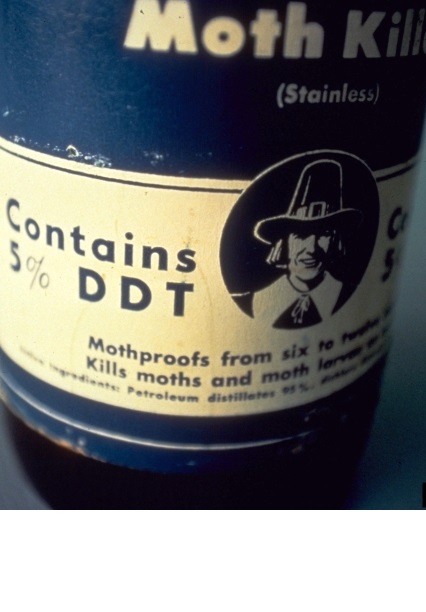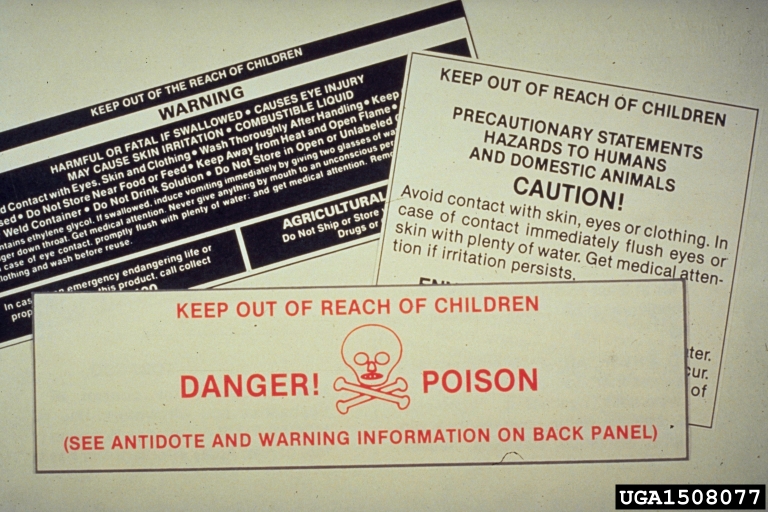 Using Pesticides Safely - August 17, 2016 Jeff Schalau, Agent, Agriculture & Natural Resources University of Arizona Cooperative Extension, Yavapai County Gardeners often encounter plant-damaging pests in their gardens, landscapes, and orchards. In these settings, pests can be: insects, fungi, bacteria, weeds, mollusks, or animals. There are pesticides to manage each of these organisms, but the first question after correctly identifying a pest should be: “Do I really need to utilize a pesticide to manage this pest?” In my experience, insecticides and herbicides are the most commonly used (and misused) pesticides by non-professionals. Before any product can be sold or used as a pesticide, the US Environmental Protection Agency (EPA) reviews all appropriate data to ensure the product will not cause undue risk to people or the environment. While pesticides have been a valuable asset in the reduction of crop losses and improving human health, they can also be harmful to people, the environment, and non-target organisms – especially when misused. When you purchase a pesticide, you are implicitly agreeing to use it according to label directions and knowingly failing to do so can constitute a crime. So, read the label and follow the directions to be as safe as possible. Insecticides and arachnicides are designed to kill or repel insects, mites, and ticks (they do not work as well for spiders and scorpions). They include products such as: garden dusts, insect sprays, soap sprays, mosquito repellents, ant and roach baits, flea shampoos, flea and tick collars, moth balls, and pheromone lures. Some insecticides are designed to kill by direct contact while others are taken in when feeding (stomach poisons). Each type of product varies in the species controlled and the time it will remain effective. Insecticides should be carefully researched before use to minimize their potential harm to non-target organisms, people, and the environment. Herbicides are designed to kill weeds and other unwanted plants. They include products such as: weed killers, weed-and-feed lawn care products, and cut-stump treatments. Herbicides can be selective (affect only broadleaf or grass plants), non-selective (kills everything), pre-emergent (kills germinating plants), post-emergent (kills existing plants), and soil sterilants (kills and prevents all plants). While these products have their appropriate uses, many times people use soil sterilants on driveways and fencerows then learn they have unintentionally killed desirable plants. These herbicides move with rain or irrigation water downward or laterally in the soil where they can be taken up by roots of trees and shrubs. Read the label and avoid products containing imazapyr, prometon, diuron, bromacil, simazine, or atrazine. In settings where no vegetation is desired, use glyphosate or glufosinate to kill existing weeds and an appropriate pre-emergent herbicide to prevent new weeds from growing. Pesticide labels contain lots of useful information. Probably the most prominent is the signal word which describes the acute (short-term) toxicity of the pesticide product. The signal word can be either: CAUTION, WARNING, or DANGER. The signal word CAUTION means the pesticide product is slightly toxic if eaten, absorbed through the skin, inhaled, or it causes slight eye or skin irritation. WARNING indicates the pesticide product is moderately toxic if eaten, absorbed through the skin, inhaled, or it causes moderate eye or skin irritation. DANGER means that the pesticide product is highly toxic by at least one route of exposure. It may be corrosive, causing irreversible damage to the skin or eyes. Alternatively, it may be highly toxic if eaten, absorbed through the skin, or inhaled. If this is the case, then the word “POISON” must also be included in red letters on the front panel of the product label. When choosing between pesticides that will achieve the desired objective and one carries the signal word CAUTION and the others WARNING or DANGER, always choose CAUTION: it is the safest choice. Speaking of safety, vegetable and fruit gardeners often try to use “least-toxic” pesticides. These include insecticidal soaps, horticultural oils, and botanically-derived insecticides. These pesticides are often used for growing crops organically, according to guidelines set forth by certification programs. Least-toxic pesticides have gained favor in recent years, due in part to the perception that, because they originate from plant material, they are more safe or "natural." Pyrethrin and neem extract are both botanically derived least-toxic insecticides. Bt (Bacillus thuringiensis) is a class of least-toxic insecticides derived from bacteria. These products are still regulated by the EPA and should be treated with the same care as conventional pesticides. As a final note, we gardeners must learn to tolerate some pest damage, use prevention, cultural, and mechanical (non-pesticidal) practices to manage pests when possible, and use pesticides appropriately and with discretion. See additional resources below. Follow the Backyard Gardener on Twitter – use the link on the BYG website. If you have other gardening questions, call the Master Gardener help line in the Camp Verde office at 928-554-8992 or e-mail us at verdevalleymg@gmail.com and be sure to include your name, address and phone number. Find past Backyard Gardener columns or provide feedback at the Backyard Gardener web site: http://cals.arizona.edu/yavapai/anr/hort/byg/.  Additional Resources Safe Use of Pesticides Around the Home Penn State Extension extension.psu.edu/pests/pesticide-education/applicators/fact-sheets/pesticide-safety/safe-use-of-pesticides-around-the-home Pesticide Information University of California Agriculture and Natural Resources ipm.ucanr.edu/GENERAL/pesticides.html Homeowner's Guide to Pesticide Safety University of Florida IFAS Extension edis.ifas.ufl.edu/pi051 |